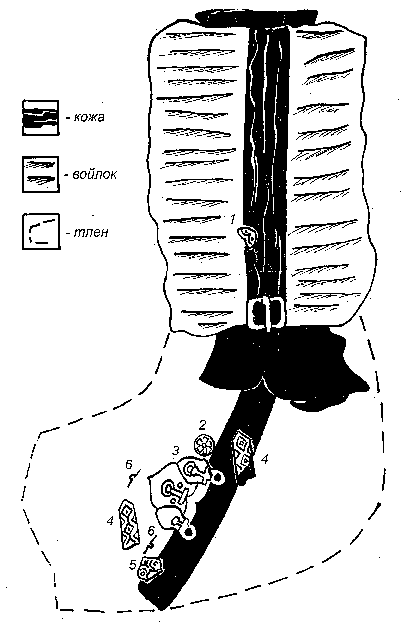|
Last Page Update:
October 17, 2001
Contact
Copyright Information
Main Page
Structure of the Red Kaganate
Gatherings, Events,...
Historic Steppes Tribes
Legends of the Nomads
Flags and other Identifiers
Clothing and Apearance
Food and related Matters
Armour
Weapons and Combat
Public Forum
Resource Links
Email:
kaganate@yahoo.com
Editor:
Norman J. Finkelshteyn
|
Studies on the Upper Saltov in
1996
Excerpt: A Khazar felt and
leather Boot Excerpted and translated by
Dmitriy V. Ryaboy
The original article excerpted below is a short report on the excavations
in Upper Saltov (Verhniy Saltov) conducted in 1996 by an archaeological
expedition from the Kharkov National Pedagogical University. The article is
excerpted and published here by permission from the original Russian article
"Issledivaniya v Verkhnem Saltove v 1996 godu" by V.V. Koloda,
Harkov National Pedagogical University -
http://archaeology.kiev.ua/journal/050901/koloda.htm.
The so-called "Saltovian culture" refers to the inhabitants of the Saltov
region in mid-8th through mid-10th centuries, this group consisted of Khazars,
Alans, Slavs, Bulgars, and others.
The examination made by V. Koloda's team showed that only a small portion of the
site is available for detailed examination, the majority of the site being covered by a
forest and modern buildings. However, examination of even the small portion of the
site that is available yielded plenty interesting material. The remains of metallurgical
production were discovered, with "many pieces of slag, fragments of a melting pot from
a Novopokrovsk-type forge." Catacombs 18 through 27 of sepulchre #4 discovered
by V. G. Bordulin in 1989 were explored (the first 17 had been explored previously).
This exploration yielded much material regarding the burial rituals, as well as a "rich and
varied" inventory of items buried with the bodies. These items included tools, weapons,
horse harness, ceramics, jewelry, and so on. V.V. Koloda specifically points out three
silver dirhems as a particularly interesting find. Of major interest are the unique felt items
found in the catacombs. Below is a translation of the discussion of these items in Koloda's
article.
| The remains of felt items are
considered unique finds. The remains of a felt hat were found on top
of the skull of one of the buried (catacomb #19). The remains of
felt-and-leather footwear were found in the burial chamber of
catacomb #22. One of the "boots" was conserved better than the other
(fig. 1). Judging by the decoration details it was a left one. Its
base was made of felt, as testified by the felt traces found on the
lower part of the item.
 Fig. 1. Remains of the leather
and felt boot from the burial chamber of catacomb 22. Fig. 1. Remains of the leather
and felt boot from the burial chamber of catacomb 22.
| The felt was better conserved on
the calf, where it was stiched horizontally and supported on the
inside by a leather base. There is a vertical strip of leather on
the outside of the shoe. A bronze rectangular buckle is attached to
it. The bottom part of the boot was also outfitted with leather
straps 1 cm wide; inside the upper part of the shoe it is attached
to the leather base, and then goes down to the sole. It is possible
that it passed under the sole and then came up over the foot on the
other side. This is supported by small pieces of leather of the same
width found in the felt remains, as well as ethnographical studies
of Eurasian nomads.
The shoe was decorated with bronze plates depicting a face (1,
3). One of the plates was round, decorated with a 6-leaf flower (2).
Also found were silver plates with a geometrical design (4), one of
which is still has a belt attached to it. The shoe was also
decorated by another type of plates -- lotus-shaped silver plates
with a face. Immideately next to the straps and the plates were thin
strips of bronze with which they were attached to one another.
The study of such an important and interesting burial definately
requires continuation.
|
